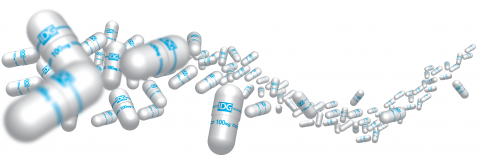ABOUT OUR CENTER

UCSF is one of three hubs of the IDG. Our objective is to apply transformative scalable technology platforms and streamlined experimental workflows incorporated with multiple robust assay and physiological perturbation protocols for large-scale functional studies of poorly characterized and/or un-annotated proteins encoded by the Druggable Genome.
At UCSF, two teams have assembled to help annotate dark protein families: the McManus Lab with the Jan Lab to focus on dark Ion Channels, and the Shoichet Lab with the Roth Lab (UNC) to focus on dark GPCRs. These teams are working together, collaborating with others in the IDG to uncover functions for human genomic dark matter.
Databases
Despite the risky nature of exploratory research, we stand to learn the greatest by studying the darkest questions.
cDNAs containing dark ion channels with V5 tag on the C-terminus in pLX304 vector were used to make lentivirus used to transduce early passage HEK293T cells for stable cell line generation. Cells were selected with Blasticidin for 10 days, expanded and then stained with V5 antibody to determine ion channel expression/localization. Images for all cells that survived the selection are shown below (regardless of the V5 status).
These cells can be cultured in regular DMEM or RPMI media with 10% serum. Based on the presented imaging data, some cell lines express the channel well, while others do not appear to express. Although this is typical, the Ion Channel IDG is working on projects that will reveal factors important for ion channel expression and welcomes collaboration.
Given the right resources, nearly everything in biology is possible.
Plasmids containing coding sequences for dark ion channel genes (longest splice isoform whenever possible) were obtained in various formats from the hORFeome, and other commercial sources. For plasmids from hORFeome collection, ORFs were already in pLX304 vector, which were used directly for lentivirus production.
For plasmids in non-pLX304 backbone ion channel ORFs were cloned into pLX304 vector using Gateway and In-Fusion strategies. Reaction mixtures for all pipelines were transformed into Stbl3 bacteria and Plasmid DNA was isolated for validation of the ion channel coding part by Sanger sequencing.
Hundreds of human genes remain ignored by the scientific community, despite that many of them are likely disease causing when mutated. Why?
These constructs allow stable lentiviral transduction of sgRNA containing plasmids and generating cell lines that can be used for CRISPRi studies.
Sequences for sgRNAs against dark ion channels were chosen from the library published in “Horlbeck et al., 2016”.The sgRNAs were ligated into a lentiviral backbone that was cut using a restriction enzyme.
PHAROS combines data from over 100 data sources so users can access, query, filter, and download data on all human protein targets.
As part of the IDG Mission of providing data for scientific community to study the dark ion channels, we compiled disease association and mouse phenotype information by mining several public databases.
These data are available below-- and if you need additional data or would be interested in collaborating on data mining related projects, please contact us.
The disease association information is harmonized from several databases, including Online Mendelian Inheritance in Man (OMIM), ClinVar, DisGeNET and Monarch Initiative database. The mouse phenotype data is compiled from the International Mouse Phenotyping Consortium (IMPC) and Mouse Genome Informatics (MGI).
An important clue to dissecting the role for a gene in health and disease is knowing the cells and tissues in which it is expressed
We characterized and quantified the expression levels of the dark genes in subsets of sensory (dorsal root ganglion; DRG) and spinal cord neurons, both in naive conditions (wild-type mice) as well as in the setting of neuropathic and inflammatory chronic pain.
We performed fluorescent multiplex in situ hybridization on DRG and spinal cord tissue harvested from wild-type mice as well as 7 days after peripheral nerve cut (neuropathic pain condition) or 3 days after hindpaw injection of complete freund’s adjuvant (inflammatory condition). Quantification was performed using Image J.
Relevant Programs and Collaborations

Reactome is pathway database which provides intuitive bioinformatics tools for the visualisation, interpretation and analysis of pathway knowledge. Founded in 2003, the Reactome project is led by Lincoln Stein of OICR, Peter D’Eustachio of NYULMC, Henning Hermjakob of EMBL-EBI, and Guanming Wu of OHSU.

The project is entirely open access and all data is made available online via this website and the website of the International Mouse Phenotyping Consortium (IMPC). All generated knockout mouse lines can be requested from the IMPC.

Pharos is the user interface to the Knowledge Management Center (KMC) for the Illuminating the Druggable Genome (IDG) program funded by the National Institutes of Health (NIH) Common Fund. (Grant No. 1U24CA224370-01).





















